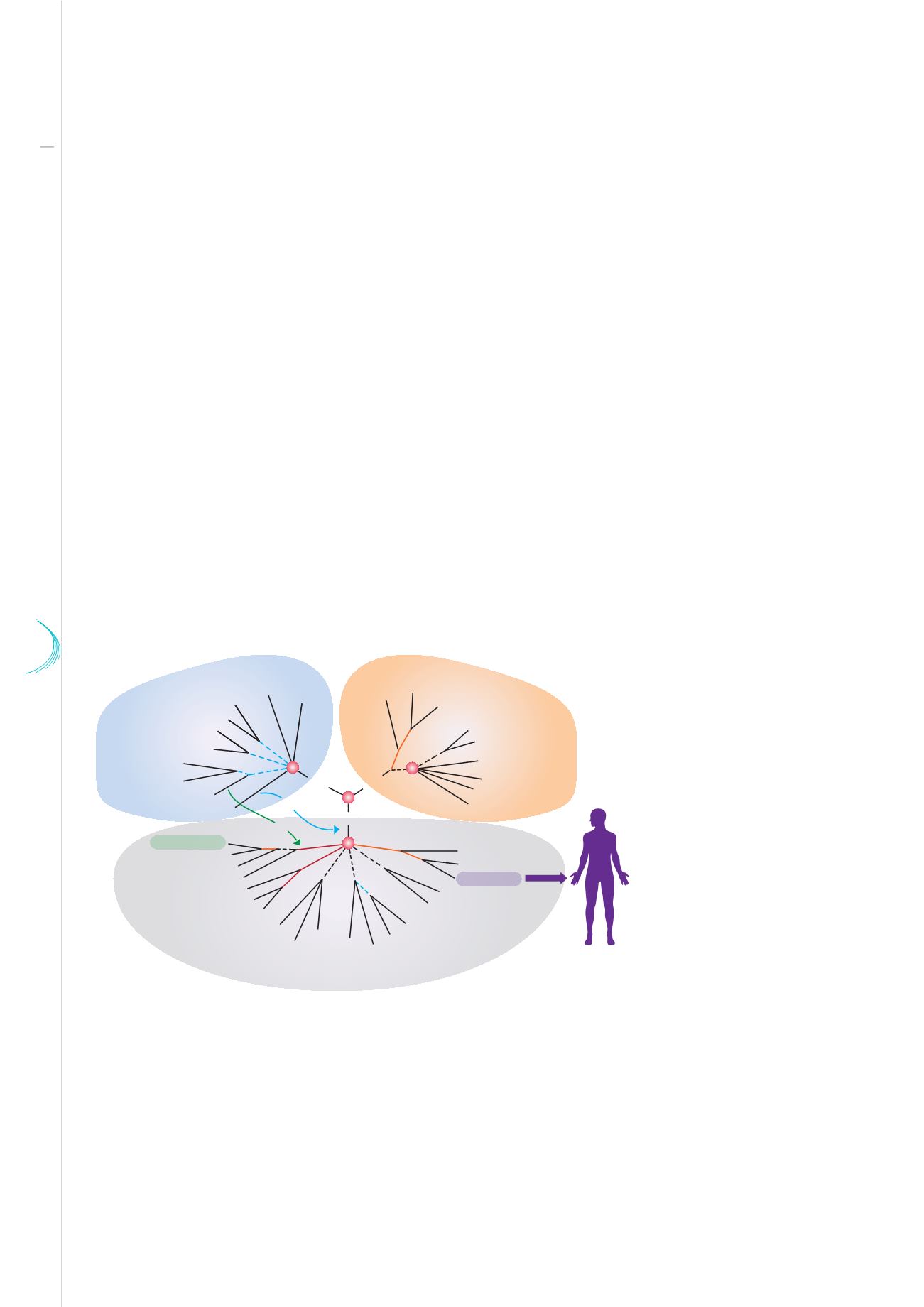

37 38
36
La Lettre
HOMO
ARCHAEA
BACTERIA
EUKARYOTA
Archaea
Bacteria
Eukaryota
Thermococcales
Methanococcales
Archaeoglobales
Thermoplasmatales
Methanosarcinales
Halobacteriales
Euryarchaeota
Sulfolobales
Desulfurococcales
Thermo-
proteales
Crenarchaeota
Plancto-
mycetales
Low-GC,
Gram positive
Thermotogales
Chlamydiales
Deinococcales
High-GC,
Gram positive
Cyanobacteria
Proteobacteria
Aquificales
Spirochaetes
Mitochondria
Chloroplasts
Opisthokonta
Fungi
Choanoflagellates
Metazoans
Radiolaria
Cercozoa
Rhizaria
Alveolates
Stramenopiles
Haptophytes
Chromalveolata
Crypto-
phytes
Jakobids
Euglenoids
Diplomonads
Excavata
Land plants
Plantae
Amibozoa
Green algae
Red algae
Glaucophytes
Mycetozoans
Pelobionts
Entamoeba
© From F. Delsuc. Nat Rev Genet. 2005 ; 6 : 361-75
Studying the genetic kinship of living species (based on ribosomal RNA) reveals a
bushy tree of life in which man appears on a lateral branch.
Step 2: cell biology and evolution
The living being is not merely a bag of enzymes: it has a shape and an organization. At the most elementary
level is the cell, which accumulates proteins and nucleic acids. With higher organisms, a nucleus is to be found
in each cell, inside a watery cytoplasm, circumscribed by a membrane made of lipids. “
Omnis cellula e cellula
”
(“
Every cell [stems from] another cell
”), suggested Virchow as early as 1855. During the development of the
embryo, not only do cells multiply, but they also differentiate into distinct types – muscular, hepatic and so on.
This microscopic diversity is in line with a broader diversification, the diversification of the general shapes of living
beings.
Starting with Aristotle, the description of species expanded in the century of the Enlightenments with the Swedish
Linné and, in our country, with Buffon. These species were classified within a hierarchy in a table illustrating some
“growing perfection” fromone to the
other.Atthe summit was seated “man”, then the Creator above, responsible for
this harmonious “
scala naturae
”. The table is fixed and immutable. Until Lamarck, on 11 May 1800, in the opening
speech of his course at the Muséum d’Histoire Naturelle, abandoned this vision of the world to the benefit of a
revolutionary concept, the evolution of the species: species are not fixed, they “transform” themselves. Darwin,
59 years later, took over the transformism thesis but abandoned Lamarck’s inheritance of acquired characters to
the benefit of natural selection as the drive of evolution. Two centuries of biological research would validate this
Darwinian model. The study of fossils has shown that species, or even entire groups, appeared and later, in great
part, disappeared. Death has become the essential cog in the evolution of life. Unexpectedly, gene transfers
occur between sometimes
very distant species, and the
tree of life becomes uncertain
and irregular. It takes the
shape of a bush, where
Homo
sapiens’
ancestors appear
on a lateral branch: human
beings are not taking pride
of place at the summit of the
scale of beings any more.
The developments of a new
discipline, genetics, would
reveal unbreakable bonds
between
evolution
and
development. As early as
1866, Mendel acknowledged the existence of stable and transmissible hereditary characteristics – such as the
colour and form of the peas he cultivated in the garden of his monastery – which he ascribed to invisible “factors”
that have been called “genes” since then. Morgan, in the 1920s, demonstrated, with the fly, that these genes
are localized on the chromosomes, in each cellular nucleus. He considered they were likely to be modified by
mutations that were transmissible through heredity. Molecular biology has established that each protein of the
organism is encoded by a genetic sequence of DNA molecule and that mutations in such sequences are at the


















